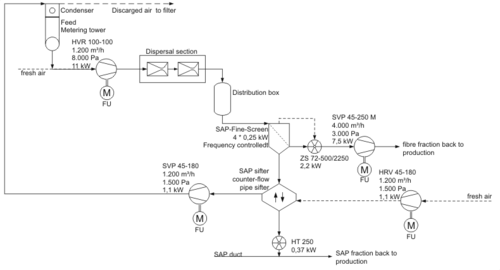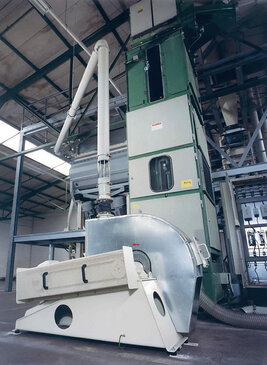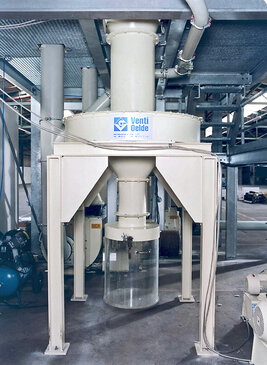Introduction
Venti Oelde has developed a plant to treat production rejects from the manufacture of incontinence and other hygiene products. This plant can treat SAP and fibrous material with a mass throughput of 200 kg/h so that both products can be returned directly to the production process. The heart of this plant is a special air dispersal unit and the sorting equipment "Vibrosap".
After its introduction in 1999 it became evident, however, that the plant was too expensive for the throughput of 200 kg/h because of its complexity and the weight of the Vibrosap.
After a period of intense development we have now succeeded in considerably reducing the price of the whole plant and, furthermore, introduced further possibilities for increasing or reducing the throughput.
Plant technology
The plant technology still consists of the three main components:
Dispersal section with special high-pressure fans and nozzle systems
Fiber separation by means of fine-line screen with specially agitated deck
SAP cleaning by means of counter-flow pipe sifter
Fig. 1 shows the flow diagram of this plant.
The relevant connecting ducting, discharge devises (such as rotary airlocks) and the fans and steel structures are also integrated into this compact plant.
The plant can be installed complete. Included is also a switch cabinet to control and operate the plant. It is possible to choose between automatic plant operation, integrated into a primary control, and manual selection of the individual units.

Dispersion

The material exits the metering tower directly into the dispersal duct. The special fan sucks the mixture of fibrous fluff surrounding the SAP granules from the dosing roller of the feed tower. The high-pressure fan is designed to transport material through the open impeller. It is driven by a frequency-controlled motor.
The first defribrating of fluff starts in the fan using shear flow. The fluff content is then loosened in the downstream dispersal duct with several special dispersing nozzles so that it is possible to mechanically separate the granules from the individual fibers. The powerful shear flow is responsible for defibration. Direct mechanical stress through impact or pressure surfaces as well as cutting is avoided. The result is that the fluff is carefully pulled apart. The fibers remain in their full length.
Fiber separation
The mixture of fibres and granules is fed evenly across the whole width of the fine screen via a distributing box. The screen deck is agitated at high frequency by several vibrating bars so as to avoid the fluff reagglomerating and enclosing the SAP granules again. The SAP-material falls through the screen cloth. This process is assisted by a slight air flow which passes through the screen from below.
The material transport is generated by the slope and the vibration of the screen. The vibrating frequency can be regulated by the frequency-controlled unbalance motors. In this way the SAP granules are completely separated from the fluff fraction. The granules can be described as SAP pre-concentrate and still include some fibres and dust. It has to be cleaned.
The SAP-free fibre fraction is discharged via an over-sized rotary airlock and returned through a material handling fan to the production process or can be stored.
SAP Secondary cleaning

The material which has passed through the fine screen is fed through a hopper to a counter-flow sifter, Fig. 3. This consists of an amply dimensioned pipe, through which a defined air volume passes upwards. The air is blown into the separator pipe from a controlled supply air fan across the whole circumference. The SAP pellets fall downwards contrary to the air flow and are discharged through a rotary airlock. The SAP can also be used again immediately in the production process.
The fibers and dust from the sifter are collected in an annulus together with the separator air and returned to the plant through a discharge air fan as defibrating air. In this way, any SAP granules still entrained in the air may be removed.
Technical data
The technical data for the plant technology are summarized in the following table:
| Recovery of SAP: | 70...90%* |
| SAP residual concentration in the fluff: | 2...8%* |
| Purity of the recovered SAP: | 99,5% |
| Sound pressure level:** | < 85 dB(A) |
| Minimum humidity: | 35% |
| Maximum humidity: | 55% |
| Throughput capacity***: | 50...500 kg/h |
| Specific data for plant throughput of 250 kg/h | |
| Total drive output: | 25 kW |
| Diameter of ducting: | NW 100 |
| Defibrating fan type: | HVM 100-100 |
| Fan output: | 11 kW |
| Total screening surface (WxL): | 1500 x 2500 mm² |
| Screen output: | 4 x 0,25 kW |
| Diameter of pipe separator: | NW 400 |
| Output of separator fans: | 2 x 1,1 kW |
* Depending on the input concentration and material properties
** Measured in accordance with DIN 45635 1 m from the plant
(simple sound enclosure possible)
*** Depending on the plant size (currently four sizes available)
The specific technical data for other plant sizes can be obtained on request. As well as the trial plant for up to 50 kg/h feed volume and a shortened screening deck, following plant sizes are available:
Throughput up to 150 kg/h
Throughput up to 250 kg/h
Throughput up to 400 kg/h
Throughput up to 500 kg/h
The main design criteria is the size of the fine screen and the separator. The defibration unit only has to be slightly adjusted.

关注万迪欧德公众号

万迪欧德抖音号
Copyright © 2022-2023 Venti Oelde (Jiangsu) Air Handling Equipment Co. Ltd All Right
备案号:ICP 2023002554 技术支持:镁诚科技